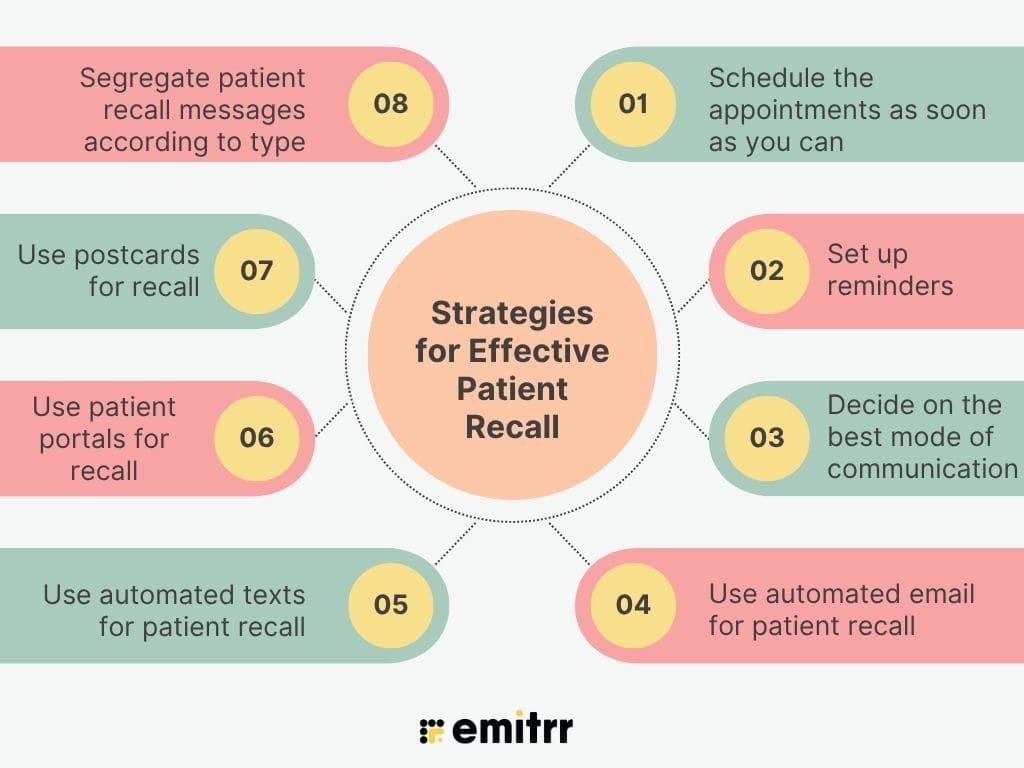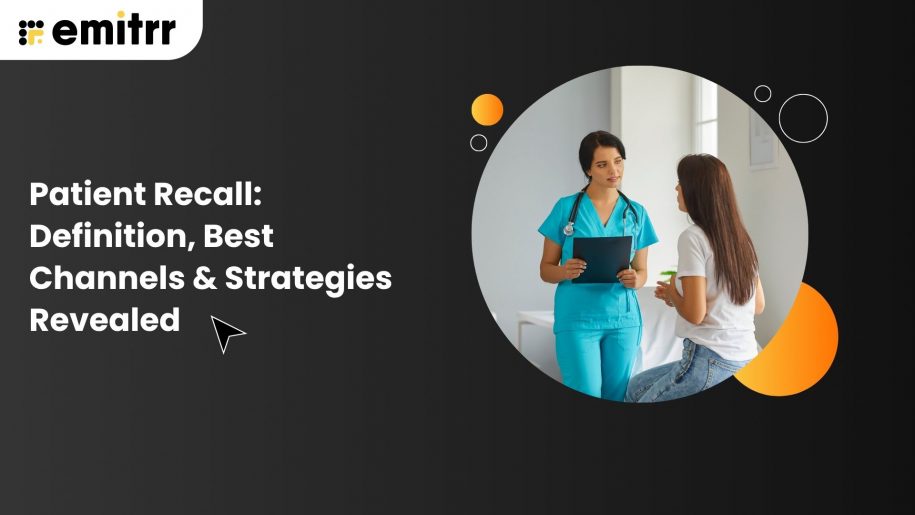What is Patient Recall?
Patient recall is the process of encouraging patients to return to the clinic for a routine check-up. Patient recalls are timed and regular appointments. These regular hygiene check-ups are essential for providing ongoing care to patients these not only ensure that the patients remain healthy and safe but also help the practice reduce patient churn.
The frequency of these check-ups may vary based on each practice’s preference and the patient’s needs.
While the patient recall period may vary from a few weeks to as long as a year in some cases it is extremely important for healthcare practitioners to keep their patients engaged during this time
Interesting fact – The average medical practice loses approximately $150,000 to $300,000 in revenue each year due to patient attrition and The estimated cost of medication non-adherence in the United States ranges from $100 billion to $289 billion annually.
Hence, regardless of the specialization and the duration of the recall, it’s important that you have a patient recall system in place. Let’s look at some of the reasons why patient recall is important for every healthcare practice.
Why Patient Recall?
According to a study by Accenture, existing patients generate 80% of a healthcare practice’s revenue. Suffice to say bringing patients back to your clinic should be your top priority.
Let’s look at some of the reasons why you should use recall
1. Increase your worth to Patients
Help your patients in maintaining regular check-ups and appointments to enhance their health outcomes. Sending them reminders for routine check-ups can aid in early disease detection and enable you to develop more effective treatment plans. Furthermore, this practice demonstrates your care for your patients, fostering a stronger sense of connection and engagement. Patient Recall can simply make your patients see your value.
2. Helps retain patients
The nature of a patient recall is system is embedded in engagement. You keep in constant touch with your patients to remind them of their upcoming scheduled check up. As patients keep up with their appointments, their healthcare needs are constantly addressed and patients are more likely to stay with the same provider or healthcare facility, leading to improved patient retention.
3. Helps save patient acquisition costs
Acquiring new patients is expensive. By applying patient recall methods, you ensure that your existing patients keep returning to your practice. Therefore, no additional costs are required to bring back these old patients. If you have a constant flow of patients through your patient recall methods, you will not need to spend extra money on acquiring many new patients. Healthcare providers often invest significant resources in marketing, advertising, and promotional activities to attract new patients. By focusing on patient recall, providers can significantly reduce these costs as they primarily target patients who are already familiar with their services and have demonstrated a level of trust and satisfaction.
Did you know?
In a study published in the Journal of general internal Medicine, a primary care practice implemented a patient recall system that involved sending personalized letters to patients who were due for preventive screenings or follow-up visits. The study found that patients who received the recall letters were more likely to return for appointments, resulting in a significant increase in revenue for the practice. Specifically, the practice saw a 20% increase in revenue from office visits and a 33% increase in revenue from preventive services.
Patient Acquisition vs Patient Retention
Patient acquisition focuses on attracting new patients through marketing efforts, while patient retention aims to foster long-term relationships with existing patients. Patient recall plays a significant role in patient retention by promoting regular appointments, ongoing care, preventive care, communication, relationship building, and ultimately improving patient satisfaction and loyalty.
| Aspect | Patient Acquisition | Patient Retention |
| Focus | Attracting new patients to the healthcare provider | Retaining existing patients within the healthcare system |
| Costs | Higher costs associated with marketing and advertising. The cost can be anywhere between $1000 – $10,000 | Lower costs compared to acquiring new patients The cost can be anywhere between $100 – $10,00 |
| Effort | Intensive efforts required to convert leads into patients | Consistent efforts to engage and retain existing patients |
4. Improves patient volume
One of the strongest indicators of effective patient recall is improvement in patient volume. Patient volume refers to the number of patients visiting a healthcare practice during a given period of time. A good patient volume indicates better financial outcomes for the healthcare facility.
5. Helps keep your schedule full
The process of patient recall includes proactively reaching out to patients for their due regular check-ups, preventive screenings, or follow-up appointments. By actively reminding patients to schedule their next visit, healthcare practices can ensure a steady flow of patients and keep their schedules full.

Strategies for Effective Patient Recall
Before setting up a recall system, you must educate your patients about the importance of regular hygiene check-ups. Regular check-ups can uncover hidden problems or help detect serious issues, if any, at earlier stages.

Once your patients understand why it is essential for them to visit your practice regularly, setting up the recall system can be comparatively easier. Here are some methods to improve patient recall in your practice:
1. Schedule the appointments as soon as you can
If you can get your patients to book an appointment while they are in your office, it becomes easier to fill up your slots and ensure the patient will return. Simply telling them to ‘come back in 6 months’ may not emphasize the importance of the hygiene check-up, and the patient may easily forget about this vague statement. Therefore, the best approach is to schedule and confirm the appointment right then and there.
2. Set up reminders
Reminding patients about their scheduled appointments should be done properly and timed appropriately. A good practice to follow is sending a confirmation text or reminder when the appointment is scheduled, followed by a reminder two weeks before the appointment, and finally concluding with a reminder 24 hours before the appointment. With Emitrr, you can schedule patient reminders according to your preferences.
Here’s how to schedule group texts instantly with Emitrr:
3. Decide on the best mode of communication
Should you use text messages, emails, or phone calls? It’s important to ask your patients how they prefer to be contacted and set reminders and other communications accordingly. You need to find software that enables omnichannel communication, allowing you to connect with your patients through their preferred channels.
4. Use automated email for patient recall
Email is often considered the most formal method of communication, and people generally don’t mind communicating through email. According to a study, 75% of patients prefer receiving recall reminders via email, which is the highest preference among all other communication methods. However, if you are uncertain about whether your patients would prefer email communication or not, simply ask them. As mentioned in the previous point, determine the best mode of communication for each patient and send reminders accordingly. If your patient prefers email reminders, you can use a template like this:
Dear [Patient Name],
We hope this email finds you well. Our records show that it’s been some time since your last appointment with us, and we wanted to remind you of the importance of staying up-to-date with your healthcare needs.
Regular appointments and check-ups are key to maintaining good health and preventing potential health problems. We invite you to schedule your next appointment with us at your earliest convenience to ensure that you are receiving the care you need.
To schedule an appointment, simply call our office at [Practice Phone Number] or reply to this email with your preferred date and time. Our staff is available to answer any questions you may have and to help you find an appointment time that works with your schedule.
We look forward to seeing you soon and helping you stay healthy.
Best regards,
[Your Name]
[Practice Name]
5. Use automated texts for patient recall
Texts have an open rate of 98% making it one of the most preferred messaging methods for healthcare practices for reminders. One important thing to keep in mind while using text messaging is to use HIPAA-compliant texting software like Emitrr to communicate with patients. You can create a list of patients who are due for recall month-wise and schedule reminders for them accordingly. A recall text template would look something like this:
Generic recall template:
Hi [Patient Name], this is [Practice Name]. We noticed it’s been a while since your last appointment. To ensure your continued good health, we invite you to schedule your next appointment with us. Please call our office at [Practice Phone Number] or reply to this text to schedule.
For preventive screening:
Schedule your preventive screening now! Early detection saves lives. Call [Practice Name] at [Phone number] to book your appointment. Stay healthy!
For regular check up:
Hi [Patient’s Name]! It’s time for your regular check-up at [Healthcare Practice Name]. Maintaining your health is important to us. Please call [Phone Number] to schedule your appointment at your convenience. We look forward to seeing you soon and ensuring your continued well-being!
6. Use patient portals for recall
If you have suggested to your patients that they create an account on your patient portal, updating the date of their next appointment on the portal becomes a simple task. Additionally, you can send reminders through the patient portal.
However, using patient portals for recall reminders presents a significant challenge. Not all patients will regularly login to the patient portal to check for updates. Therefore, even if reminders are set on the patient portal, there is no guarantee that they will reach the patient. Older patients may feel uncomfortable with patient portals and may choose not to use them at all. As a result, alternative communication methods such as phone calls, emails, and text messages are better options for improving patient recall.
7. Use postcards for patient recall
Postcards have been utilized by medical practices as another method to remind patients of their upcoming appointments. They are often chosen for their personal touch. Dental practices, for instance, commonly use dental recall postcards. These postcards typically include a message from the dental practice, the patient’s name, the date of their last visit, an invitation to schedule the next appointment, or a call to action to confirm the scheduled appointment.
However, dental recall cards, or recall cards in general, come with a set of challenges. Firstly, they can be quite expensive. Depending on the type of recall card you send, the cost for 100 postcards can range from $35 to $70. Secondly, the cost of delivering the postcards also needs to be considered, with postcard stamps costing around $0.50.
Thirdly, aside from the cost of the postcards, the effectiveness of the postcard as a reminder method is somewhat questionable. This is primarily because the call to action on the postcard usually involves the patient calling the clinic to confirm or schedule the appointment. It relies on the assumption that the patient will take the time to call your office. What if they fail to do so? The effort you made could end up being in vain.
8. Segregate patient recall messages according to type
Segregating recall messages based on the type of appointment can also help create a personalized touch. By recall messages based on type, we mean two categories: General and Specialized. General messages can be used for annual wellness checks or regular hygiene checkups. Specialized messages, on the other hand, can be tailored to the patient’s specific course of treatment. For example, if a patient is undergoing a treatment plan that involves four clinic visits in three months, the reminders can include the next step of the treatment that the patient needs to come in for. Here is an example:
“Hey {{patientname}}, this is a reminder that the next step of your {{procedure}} is scheduled for {{date}} at {{time}}. It is crucial for the success of your {{treatment}} that you do not miss this appointment. If you are unable to make it, please select an alternative appointment date here so that we can ensure your continued care.”
This approach helps personalize the recall messages and provides specific information to patients based on their treatment plans.
Bonus: Using Panel Management to Increase Recall Rates
Panel management includes identifying patients with unmet chronic and preventive needs. The clinic staff, hygienists, and doctors work proactively to run panel management effectively. The process involves:
1) Identifying patient populations with unmet care needs and
2) Doing personalized outreach for the identified patients informing them about checkups or procedures which are due for preventive care. This includes physician recommendations for the patients.
How will panel management help in improving recall rates? Panel management will help improve doctor-patient relationships as you get more and more involved with the patient. When the patient sees that an extra effort is being made from the clinic’s end, it can translate to better patient experience and better patient engagement , leading to an increase in recall rates.

A Comparative Analysis of Texting vs Calls vs Email vs Postcards as Patient Recall Communication Channels
| Channels/Features | Pricing | Delivery time | Response Rate | Effectiveness |
| Texting | $0.02 (approx) | Instant | 45% | High |
| Phone | $0.25/ minute (approx) | Instant | 70% | High |
| Free | Instant | 6% | Medium | |
| Postcards | $0.48 (approx) | Upto 1 week | 2.7% – 4.4% | Low |
Key insights:
- Postcards are an expensive option which is also slowly becoming extinct. Conversion through postcards is also a bit difficult as patients have to go the extra mile to confirm their appointments (i.e. calling the intended practice).
- Phone is a cheap option that also guarantees a better response rate. However, the issue with calling is that it might come off as intrusive if not done at the correct time. It is a good option to keep the older population looped in about their appointments, as they might not be tech-savvy.
- Email communication is the most accepted means of communication for recall reminders. It doesn’t cost anything and can be effective if it has been chosen by the patient specifically for communication. However, the response rate of emails is on the lower end.
- Text messaging is a great channel for recall reminders since it is cheap, delivery is instant, and also has a high response rate. Add to it the open rate of texting, i.e. 98% and you have yourself the best channel for patient communication.
How You Can Use Emitrr to Automate Patient Recall?
Manually keeping track of patient check-ups isn’t something that is feasible. It would require a lot of effort and time from your staff, time which could be used for other important tasks. So how can you make this process faster and more efficient? The answer is, using a patient interaction and engagement software like Emitrr.
Emitrr can integrate with your existing PMS and gather relevant data about the next required appointment date for patients. This data sync will be used to schedule relevant appointment reminders for the upcoming patient check-up. Once your patient data is synced with Emitrr, you can follow these steps to set up a patient recall reminder for the upcoming appointments:
Step 1: Go to text campaigns > Automated on the left navigation panel
Step 2: Select “recall” campaign
Step 3: Set the interval for the recall text message
Step 4: Set the cadence for the reminder texts
Step 5: Choose your preferred recall template
Step 6: Select ‘save’
Frequently Asked Questions
To automate the process of patient recall, you can invest in software such as Emitrr. Emitrr allows healthcare practitioners to send automated reminders and text SMS based on the information available in their PMS/EHR system. It also allows you to customize the recalls and schedule them for a specific day and time.
For treatments that are not urgent your patients may forget and miss giving you a visit again. By reminding and educating your patients, you can ensure they come back to you. Also, patient recall is much more cost-effective as compared to attracting a new patient.
You can send patient recall SMS to your patients manually, but that can be very time-consuming and impractical. So the best way to carry out patient recall is by using software like Emitrr, which automates the entire process via SMS by syncing with your PMS/EHR software.
Conclusion
A key takeaway is that retaining your existing patients can contribute up to 80% of your revenue. Therefore, it is essential to ensure that the recall system you choose does justice to this figure. Implementing a re-care system for your patients will not only help them stay safe and healthy but also contribute to the success of your practice.
There are several methods you can use to implement recall, including phone calls, emails, texts, and postcards. To determine the best method for your practice, it is important to ask your patients about their preferred communication method. By implementing their preferred method of communication, you can improve the response rate and ultimately enhance the recall rates.

 4.9 (400+
reviews)
4.9 (400+
reviews)
